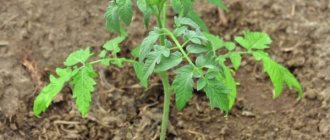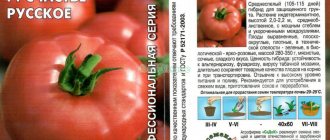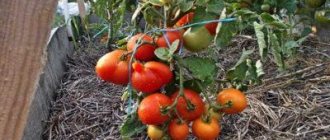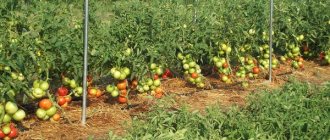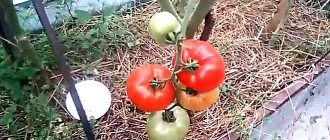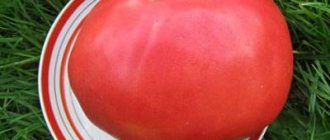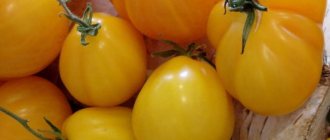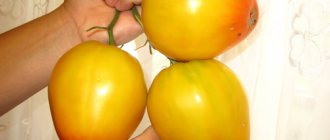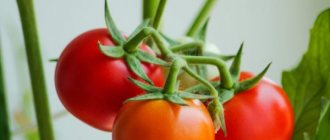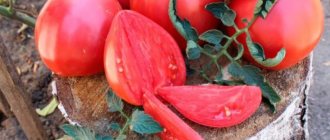Description of tomato Yamal 200
Tomatoes of the Yamal variety and the subsequent Yamal 200 are absolutely identical both in appearance and in varietal characteristics. The second representative has slightly larger fruits and increased immunity against infections. Tomatoes belong to the determinate type. Characteristics of the variety:
- compact standard shrub, 50 cm high in greenhouses, 35 cm in open areas;
- the main trunk is strong, thick, there are few young shoots, all of them are used to form a bush;
- foliage is medium, leaves are light green, long, narrow, with corrugated edges, densely pubescent;
- simple clusters are formed after 6 leaves, have 5–7 fruits, the subsequent ones are located after 2 leaves;
- The flowers are yellow, 85% of them produce ovaries.
The Yamal tomato, according to the description of the variety and reviews from vegetable growers, ripens 2.5 months after planting, the first harvest occurs at the end of August.
Description of fruits
The variety "Yamal 200" ripens unevenly, and the weight of the fruits of the lower clusters differs from the subsequent ones. Characteristics of the fruit:
- the diameter of the tomato is 8–13 cm, weight 105–225 g, the numbers are relative; there is a deviation upwards and downwards;
- The shape of the tomato is round, slightly flattened at the top and bottom;
- the surface is smooth with a glossy shine;
- the peel is dense, bright red in color in a state of biological ripeness, unripe fruits are light beige, milky in color;
- the pulp is thick, juicy, without voids;
- The Yamal tomato produces few seeds; they are placed in 4 chambers.
The tomato tastes sweet and sour with a strong nightshade scent.
Transplanting seedlings
Transplanting seedlings is carried out on a warm, dry day, having previously prepared the beds and soil.
In open ground
The area for planting tomatoes is prepared in advance. The soil is dug up, mixed with organic matter and mineral fertilizers, and thoroughly loosened.
See also Features of cultivation, characteristics and descriptions of the Benito tomato
Planting holes are dug in the prepared bed, into which the seedlings are transferred along with a lump of fertile soil. The bushes are sprinkled with earth and watered with warm water. The top of the beds is mulched with humus or straw.
Expert opinion
Stanislav Pavlovich
Gardener with 17 years of experience and our expert
Ask a Question
Important! On 1 square meter no more than 4 vegetable bushes are placed. Otherwise, the plants will interfere with each other's growth and development.
To the greenhouse
The seedlings are transferred to greenhouse conditions in mid-May. The planting technology is the same as in open ground. The bushes are placed at a distance of 35–40 centimeters from each other, with a gap of 50–60 centimeters left between the rows.
Characteristics of tomato Yamal 200
A tomato variety of limited growth, created for cultivation in cold climates. Refers to early ripening tomatoes, medium fruiting. The hybrid does not require the formation of a bush, the removal of stepsons, and in open ground there is no need for staking. In a greenhouse, when the yield is high for the variety, a trellis is pulled.
Productivity and fruiting
Yamal tomatoes are not high-yielding varieties; their priority is frost resistance and resistance to most fungal infections. The growing season of a tomato does not stop if the air temperature drops to +8o C. To start ripening the fruits, + 15o C is enough. In a greenhouse, an early crop will produce the first harvest on the 95th day after planting the seedlings. In an open area, ripening time increases by 2 weeks.
Attention! The variety is suitable for storage; the last fruits of milky ripeness ripen well, retaining their taste for several months.
The harvest takes place in late August - mid-September. According to reviews, one tomato bush “Yamal 200” produces an average of 4 kg of fruit, with 1 m³ yielding up to 15 kg. The indicator depends on the temperature regime and correct agricultural technology. The lower the temperature, waterlogging of the root circle and fertilizing, the lower the established norm, the worse the fruiting.
Area of application of fruits
The Yamal 200 variety is not cultivated on farms for commercial purposes due to its low yield. Tomatoes are grown in garden plots. Consumed fresh, used for making juices, adjika, and ketchup. The hard peel tolerates heat treatment well, and the size of the fruit allows the tomatoes to be used for preservation in glass jars.
Resistance to diseases and pests
Yamal tomatoes, according to the stated characteristics, belong to a variety that is resistant to viral, bacterial and fungal infections. Pests native to the region where tomatoes are cultivated are affected in the same way as any type of nightshade. In a greenhouse, high air humidity is a favorable environment for late blight; fungal spores spread very quickly and can destroy most of the plants. Thanks to the genetic material of the wild crop, tomatoes in open areas do not get sick even in rainy summers.
Advantages and disadvantages of the variety
According to reviews, the Yamal tomato has no disadvantages; the only disadvantage of the variety is the unprofitability of industrial cultivation. The advantages of the Yamal 200 tomato include:
- Endurance. Fruiting is not affected by sudden changes in day and night temperatures or prolonged lack of watering.
- Stable yield of the variety throughout the summer.
- Resistance to diseases and parasites.
- Early fruit ripening, tomato is not afraid of low temperatures.
- The bush of the variety does not require formation; there is no need for constant removal of stepsons or tying up.
- The plant is low, compact, and takes up little space in the planting area.
- Fruits of a variety with good gastronomic characteristics.
- Even tomatoes do not vary much in size and lie well.
- Variety of universal use.
Advantages and disadvantages of the variety
Yamal tomatoes are one of the best cold-resistant varieties. Even in cool weather, the tomatoes set, and their taste is quite good. This is the variety chosen by summer residents of the northern regions.
Thanks to early ripening, Yamal tomatoes have time to turn red on the bush
pros
- cold resistance (can set fruit even when the temperature drops);
- can be grown in almost all regions of Russia;
- good yield;
- pleasant taste;
- low maintenance requirements;
- good resistance to crown and root rot, late blight;
- all-purpose tomatoes;
- dense skin – tomatoes retain their shape and do not crack;
- fast ripening times.
Minuses
- taste and ripening time depend on weather conditions;
- Sometimes a garter may be required.
Growing rules
Tomato variety “Yamal 200” is cultivated with seeds. Planting material can be purchased at the retail chain. Tomatoes are propagated using seedlings grown in advance and sowing the sprouted seeds directly into the ground.
Attention! Tomatoes are planted in open ground using sprouted material only after the soil has completely warmed up.
Planting seedlings
The variety “Yamal 200” is early ripening; seeds are planted for seedlings 45 days before placement in a permanent plot. It is recommended to plant tomatoes in containers, then plant them in a large container. To avoid replanting, the seeds are planted in groups of 3 in peat cups. Algorithm of actions:
- The planting material is spread in a thin layer on cotton cloth and moistened.
- After sprouts appear, the seeds along with the tissue are placed in a manganese solution for 2 hours, then treated with a growth stimulator.
- Peat and organic matter are poured into the planting container in equal parts.
- Make furrows 3 cm deep, carefully lay out the seeds so as not to damage the sprouts, and water them.
- Cover with film and put in a warm place for 4 days to create a greenhouse effect.
Within four or five days, the seedlings will germinate, the covering material is removed, and the containers are placed in a well-lit place. After the appearance of 4 leaves, the plant is planted in separate plastic or peat cups.
Tomato transplant
The seedlings grow for about 1.5 months, then they are placed in a greenhouse. Seeds are sown in mid-April, young shoots are planted at the end of May. If tomatoes will grow in open ground, you need to focus on the climate. They count 2 months from the end of frost and begin to sow seeds for seedlings.
Before selecting planting material for the site, prepare the soil for tomatoes: loosen the soil, remove weeds, apply organic fertilizer. Deepenings are made to cover the length and width of the root system, and the seedlings are placed vertically. 55 cm are left between the rows, planting holes are distributed at a distance of 45 cm. 4 Yamal 200 tomatoes are planted per 1 m3.
Subsequent care for tomatoes
Tomatoes of the Yamal 200 variety do not require special agricultural technology. After planting in a permanent place before flowering, it is recommended to apply nitrogen fertilizers, after 14 days phosphorus. Tomatoes are watered no more than once a week; the variety does not tolerate waterlogging of the soil. Before the first cluster appears, the plant is earthed up, the procedure is repeated 3 times during the entire growing season. The stepsons are not removed, the bush forms on its own, no garter is required.
Agricultural technology
Yamal tomatoes are planted in a permanent place when the soil warms up and the threat of frost disappears. Disembarkation times vary by region :
- southern - end of April;
- central – after May 10;
- northern - the last days of May or the beginning of June.
Knitting mittens for beginners: step-by-step lessons with diagrams and descriptions
High-quality plants should not be stunted or overgrown.
Sowing seeds directly into open ground is possible in the southern and central regions . But in this case, the harvest will be harvested much later.
Planting in open ground
For tomatoes, choose the sunniest place in the garden . Potatoes should not grow near the beds. In autumn, the selected area of the garden is cleared of plant debris. Humus is spread over the beds. If you need to reduce the acidity of the soil, dry lime is added to it.
In the spring, the beds are dug up . Formed plant roots are removed. Then they are watered with a solution of chicken droppings and ash.
The holes are dug in staggered rows . A 50×60 pattern is used. For 1 sq. m place 4-5 plants. A liter of water is poured into each well. The plants are removed from the pots along with a lump of earth, placed in holes and buried down to the first lower leaves, which are removed.
Basic rules for caring for plants
Yamal bushes do not need shaping .
They don't need to be stepsoned. Experienced gardeners advise removing a few leaves at the bottom of the bush. But since many fruits form on the bushes, under their weight they bend to the ground. Therefore, despite the low growth, the bushes of this tomato are tied up. For this, a synthetic thread is used. Water the tomatoes every 2 days . Use at least 2 liters of warm water per plant. Water should not fall on the above-ground part of the bush.
After each moistening, the soil is loosened . This prevents the formation of an earthen crust that disrupts root air exchange. The tomato beds are weeded every week. Weeds need to be removed while they are still weak and small. Otherwise, they will damage the roots of the tomatoes.
Tomatoes are fed every two weeks with root and foliar fertilizers.
How to get maximum yield
From 1 sq. m of Yamal tomato harvests from 9 to 17 kg of fruit . To get the maximum harvest in the earliest possible time, you need to know a few tricks.
Fertilizers play an important role in growing Yamal. Every 2 weeks use the following formulations :
- Take 10 g of ammonium nitrate and 40 g of “Superphosphate” per bucket of water. Tomatoes are fed with this composition 10 days after picking in a permanent place.
- Then, every 2 weeks, “Nitrophoska” and ammonium nitrate are added.
- are sprayed with foliar fertilizers every week . To prepare such compositions, take 10 g of “Superphosphate”, potassium sulfate and urea per bucket of water.
On hot days, the frequency of watering is increased . One plant should require 2.5 liters of water.
Choosing the right time for picking tomatoes is important . They are transplanted into open ground on cloudy days or at sunset.
On a note. It is recommended to plant basil, coriander and mustard between the rows of tomatoes. This will repel pests.
To speed up the pollination process, the bushes are shaken regularly. This must be done carefully so as not to break the stem.
Protection from diseases and pests
Yamal has high immunity to most diseases that affect this crop, even late blight. He is not afraid of this disease even at the end of summer, when late blight is active.
To minimize the risk of plant infection, it is important to follow the rules of prevention :
- All tools used to work with plants are disinfected . This also applies to containers for seedlings, seeds and soil.
- Remove all remnants of plants that grew in the garden last year. Pathogens develop on them.
- Regular weeding is another measure to prevent the disease. Weeds attract harmful insects.
- It is important to follow the rules of watering and apply a sufficient amount of fertilizer. If these rules are violated, the protective powers of tomatoes are reduced.
- To protect against insects, bushes are sprayed with soap solution, decoctions of chamomile, dandelion and celandine. Large pests are collected by hand.
Pest and disease control
Tomato variety "Yamal 200" is genetically adapted against fungal, bacterial and viral diseases. Pests on the plant are extremely rare; in the conditions of the risky farming zone, most southern parasites do not survive. In a greenhouse, if the humidity is high, aphids may appear; for prevention purposes, tomatoes are treated with Bordeaux mixture. The Colorado potato beetle is a threat when grown outdoors; special preparations “Sonnet” and “Commander” are used against it.
Prevention against fungal infection is treating tomatoes with 5% copper sulfate, weeding and removing weeds. It is necessary to comply with crop rotation requirements: you cannot place tomatoes in a place where nightshade crops (potatoes, bell peppers, eggplants) were previously grown. Before sowing, the seeds should be soaked for several hours in a manganese solution.
Growing Yamal tomatoes: a step-by-step guide
Like many other hybrids, the Yamal tomato (the characteristics and description of the variety is above) is grown mainly by seedlings. This is explained by the fact that when planting directly in the beds, the harvest can be obtained a whole month later. We divided the whole process into several stages.
We grow seedlings
This is a rather complicated process, especially if it is done at home. The first thing to do is prepare everything you need.
You need to prepare the following:
• Light and loose soil. You can buy ready-made or prepare it yourself (garden soil, peat, sand, humus are often used). When choosing the second option, do not forget to destroy all living organisms in the soil. To do this, fry it in the oven, pour boiling water or a solution of potassium permanganate over it. • Suitable containers. First, the seeds are usually planted in one large box, and then the sprouts are transplanted into separate cups or pots with a volume of at least 0.5 liters. All containers must be equipped with drainage holes at the bottom. Many farmers prefer not to injure the roots of young plants, so they sow the seeds directly into separate peat pots. This way you can avoid picking and plant sprouts along with containers in the beds. • Lighting. For tomato seedlings to look healthy, they need 12-16 hours of daylight. Only additional lighting can provide this condition, because at the beginning of spring there is not enough sunlight. Use LED or fluorescent lamps for this purpose. Incandescent lamps are least suitable. • Seeds. Choose seeds only from trusted manufacturers, otherwise you risk not getting the result you expect. You can independently collect material for planting next season only from non-hybrid varieties.
Preparing the seeds
Seeds that you are not sure about, pickle them in a solution of potassium permanganate for 20 minutes or in hydrogen peroxide (2-3%) for 10 minutes. After this, many summer residents prefer to germinate the seeds. To do this, they place them in warm water for 10-20 hours (it needs to be changed periodically), and then lay them out between layers of wet cloth and wait for germination. Planting should begin when the shoots just appear. Large sprouts may break when planted.
Pollock caviar: properties, benefits and harm. Recipes with pollock caviar
Let's start landing
The best time for the event is the last ten days of March. Place the seeds on the surface of the soil in a box, keeping a distance of 1 cm, spray them with warm water and sprinkle with a centimeter layer of soil. Now you can cover the container with a bag and place it in a well-lit place where the temperature will be 24-25 °C.
Caring for seedlings
What to do after the shoots appear? We provide you with a description of the main recommendations:
• As soon as sprouts appear above the ground, remove the cover and leave the container in conditions of good lighting and low temperature (15-16 ° C). • After a week, raise the air temperature to 20-22 °C. • When 1-2 leaves develop, seedlings should be planted in separate pots. • One to two weeks before planting, begin hardening off the seedlings by moving them outdoors. At first it can be for half an hour, and at the end for the whole day. • At 60-65 days of age, transplant the plants into beds.
Water the seedlings moderately so that the moisture does not stagnate. But don’t let the soil dry out either. Don't forget to loosen the soil regularly. Provide additional light to tomato seedlings from 12 to 16 hours a day. If the soil is initially not nutritious enough, feed the young tomatoes with a suitable product.
How to increase the yield of a variety in a greenhouse
It is known that tomatoes grown in a greenhouse have high yields. But to achieve a high yield of Yamal tomatoes indoors, some effort is required.
- First, you need to properly prepare the seeds: before sowing, they are placed in a solution of potassium permanganate for 30 minutes. After this, the seeds are washed and immersed in an infusion of ash for a day. After 24 hours, they are taken out and laid out on a piece of cloth and placed in a plastic container with a lid, where the seeds will begin to germinate.
- When the sprouts hatch, they are placed in the refrigerator overnight and taken out during the day. This procedure is repeated several times, which helps to harden future plants.
- It is best to plant tomatoes in a mixture of soil, river sand and humus. It will also be useful to add superphosphate and wood ash, which have a beneficial effect on nitrogen absorption.
- The seeds are planted to a depth of about a centimeter and the boxes with seedlings are covered with film. After about a week, shoots appear and the film can be removed. Fluorescent lamps are fixed above the boxes, which are turned on for 4 hours in the morning and 5 hours in the evening. The temperature in the greenhouse during this period should be about 18 degrees.
At the beginning of March, seedlings can begin to be planted in the ground. Tomatoes need a large space for nutrition, therefore between bushes there should be approximately 30 cm, and between lines - approximately 80 cm
The soil in the greenhouse should be fed with superphosphate and ash. It is important to monitor the temperature in the greenhouse: during the day it should be about 22 degrees, and at night - about 17. After the fruits appear, it is recommended to increase the temperature by a couple of degrees. It is necessary to regularly fertilize tomatoes with a solution of cow manure.
This watering is done once every 10 days. It is harmful to overfeed plants; it is especially dangerous to feed them with pure manure. Tomatoes need frequent watering. The frequency in this case will depend on the weather and the size of the plant. The higher the temperature and the larger the bush, the more abundant watering it requires. To avoid a number of diseases that can affect tomatoes, it is recommended to carry out preventive treatment of plants with a solution of copper sulfate or copper oxychloride.
Harvest and storage
Harvesting begins in the last ten days of August. The first fruits are characterized by larger sizes, subsequent tomatoes have a noticeably smaller shape and are more suitable for preservation. Tomatoes are not suitable for long-term storage. Picked ripe fruits are stored for no more than 5 days. If you pick green tomatoes for ripening, their shelf life will increase many times (up to 20 days).
Before the onset of frost, all fruits must be collected. At the beginning of ripening, harvesting is carried out once every 2-3 days, and during mass ripening - daily.
Collection of tomatoes for processing and storage involves their careful selection. Sorted fruits must be healthy, whole and not overripe. Well-dried tomatoes are placed for storage in a special container with the cuttings facing up. The container should not contain more than 10 kg of tomatoes, otherwise the lower layers will be damaged under pressure.
Description of fruits, yield
The shape of fully ripened red tomatoes is round to flat, the ribbing is weak, and a characteristic pit forms near the stalk.
The tomatoes have a bright tomato taste, the flesh is fleshy and juicy. The skin is dense, the tomatoes are perfectly stored and transported, maintaining an excellent fresh appearance.
The Yamal variety is universal in use and consumption. Tomatoes are cut into fresh salads, juices are squeezed, pastes are made, ketchups are made, canned, pickled whole and into slices. The tomatoes hold their shape perfectly.
The yield is high; with good care and favorable conditions, an average of fifteen kilograms of fruit are harvested per square meter.
Features of growing Yamal in a greenhouse and open ground
Yamal in the middle zone and in the south of Russia is grown in open ground, in the northern regions - in greenhouses and hotbeds. It is recommended to sow tomato seedlings at the end of March, and in the southern regions direct sowing into the ground under temporary shelter is allowed. Seedlings in the phase of 1–2 true leaves dive. Caring for young plants consists of watering and fertilizing. Before budding, the seedlings are fed once every two weeks with nitrogen-containing fertilizers (urea, ammonium nitrate, infusion of chicken manure (1:20), sodium humate, etc.).
Yamal already demonstrates its varietal characteristics during the seedling period: the bushes are low and do not stretch
Seedlings grown on a windowsill are hardened off 7–10 days before the planned planting in open ground. The planting pattern for Yamal is 50x40 cm. A handful of humus or compost is added to each hole, as well as 1 teaspoon of superphosphate and any potassium salt, except chloride (potassium sulfate, Kalimag, etc.). This supply will be enough for miniature bushes to last all summer.
Although the description of the variety says that a garter is not needed, the bushes, no matter how strong they are, will still fall under the weight of the fruit. Gardeners, following the recommendations, do not install supports, but lay down dry straw or grass. It turns out that Yamal is grown spread on top of mulch.
Video: Yamal tomato ripens in open ground
In greenhouses, bushes grow higher than the stated size - up to 70–100 cm. Of course, they are tied to trellises and formed into 2–3 stems. Both in open and closed ground, it is advisable to remove stepsons growing below the first fruit cluster. Then the tomatoes will be better ventilated and illuminated by the sun, which will have a positive effect on the health of the bushes, the size and taste of the fruit. On a thickened bush, the fruits are smaller and ripening begins later.
Reviews
Reviews from gardeners about the Yamal tomato are positive. The variety is popular due to its early ripening and high yield.
Natalya Kirichenko, Tver: “I’ve been growing Yamal for several years now. For early ripening tomatoes it has excellent taste. From 1 sq. I collect several buckets of crops per season. It's easy to care for. There is no need to pin or tie it up.”
Ksenia Orlova, Belgorod: “This year I tried to plant Yamal. I'm happy with the result. Reminds me of Zhenya, but longer-lasting. The tomato taste is normal. We eat the first harvest in a salad. When pink and yellow tomatoes ripen, we use Yamal for preservation. The fruits are exactly as in the photo.”
Reviews about Yamal tomato are only positive. It is beneficial for growing tomatoes for sale, as it has good shelf life.
Thanks to its fleshy pulp, it is suitable for preparing salads, juices and all types of homemade preparations.
Gardeners claim that the variety fully corresponds to its description. It produces a lot of fruits, dense in structure but juicy. In favorable conditions, plants can grow more than 1 meter.
The risky farming zone dictates its requirements for tomato varieties grown in open ground. They must be early or ultra-early, adapt well to changeable weather conditions, and be resistant to disease. It is desirable that they are well stored and transported over long distances, and the taste does not disappoint.
Breeders put a lot of effort into developing varieties that meet all these requirements. Among them is Vladimir Ivanovich Kozak. Over his 46 years of work, he has developed many tomato varieties based on wild currant tomatoes, which give the plants resistance to diseases and excellent adaptation to any climatic adversity. One of these varieties is Yamal 200, reviews from those who planted it were only positive.
Let’s take a closer look at the description and characteristics of the variety, look at photos of the fruits, and find out the peculiarities of cultivation.
Sokolova Tatyana Ivanovna, 50 years old, Chelyabinsk
I have been growing tomato “Yamal 200” in open ground for 5 years. I want to share my experience so as not to waste time on seedlings. I plant the seeds immediately in the designated place. I cover each hole hermetically with a plastic bottle or film, insulate it at night, and open it during the day. After the sprouts appear, I remove the covering material during the day and cover it at night. I continue these actions until the optimal night temperature is 8o C. Then I remove the protection, and the tomatoes grow on their own
Ignatova Svetlana Olegovna, 40 years old, Krasnoyarsk region
I tried to grow different tomatoes on the plot and grew them in a greenhouse. I couldn’t choose a variety for an open area. I accidentally saw a photo of a Yamal 200 tomato on the Internet, read the reviews of those who planted it, purchased seeds, grew seedlings, and planted them in open ground at the end of May. There was minimal hope of success. I was pleasantly surprised: the tomatoes ripened until the first frost and required virtually no care other than weeding. I liked the taste of the fruit and made some preparations for the winter.
Picking tomatoes
In a common container, seedlings are grown until a certain period. Gardeners need to monitor the number of leaves. As soon as the third one appears, the seedlings are planted in separate containers. Their preparation must be approached by carefully fulfilling all requirements (drainage holes, disinfection). The optimal size of pots: diameter - up to 10 cm, depth - up to 8 cm. The soil used is universal, the same one that was used earlier will do. Picking tomatoes is done to develop the root system.
When transplanting seedlings, it is necessary to fertilize with fertilizers. For these purposes, it is better to take peat-humic mixtures. Fertilize for the first time after a week. Repeat the procedure approximately every 14 days.
